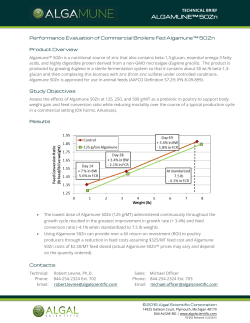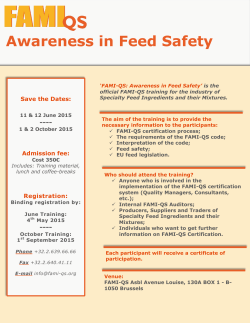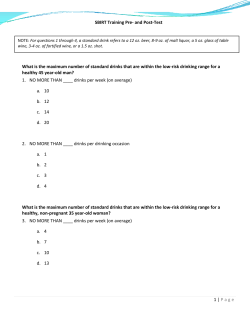
University Santa Catarina, Brazil use of BioAktiv Salis
Effect of BioAktiv Salis-G addition to drinking water on table poultry production with reference to sanitary conditions and problems caused by enterobacteria Tiago Goulart Petrolli Professor, Universidade do Oeste de Santa Catarina – UNOESC 1. Material and methods The trial took place at a self-contained commercial operation located in the western part of Santa Catarina state with the aim of assessing the effects of BioAktiv Salis-G addition to the drinking water of table poultry as reflected in the development of broilers aged from 8 – 45 days. Poultry production conformed to the methods and regulations applicable to commercial farms, and the pedigree book. Of the two poultry houses used, no. 1 had 6,500 animals and no. 2 6,600 animals, all of the HUBBARD race. Drinking water plus additive was administered as shown in Table 1. Table 1 - Treatments Treatment House 1 Additive BioAktiv Salis-G added to drinking water – 1 kg / 5,000 l of water House 2 No additive (only water) Before the additive was introduced, the broilers showed retarded growth and high mortality due to bacteria in their environment. Growth was delayed by up to eight days. At the age of 47 or 51 days the broilers were slaughtered (Table 2), followed by determining final weight, feed consumption, mortality and the production efficiency index (PEI). Data was taken from development logs kept in the houses and provided by the farm. 2. Results and discussion Results are listed in Table 2 (development of broilers per house) which shows significant differences (P>0.05) in final weight and feed conversion. Broilers with BioAktiv Salis-G in their drinking water had higher final weights and therefore better feed conversion than animals without the additive. This was mainly due to lower levels of ammonia in the environment as a result of adding BioAktiv Salis-G to water so that development was improved. Table 2. Broiler development with/without addition of Bioaktiv Salis-G Final wt. (kg) House 1 (Bioaktiv Salis-G addition) House 2 (no addition) P value Feed consumption/ broiler (kg) Feed conversion Mortality (%) Days in house PEI 2.770a 4.73b 1.71b 3.01b 47 344a 2.640b 5.33a 2.02a 6.06a 51 244b <0.050 <0.050 <0.050 <0.050 <0.050 ab Different letters in a line indicate a considerable difference in the Tukey test with a significance of 0.05 hin. Similarly, there were favorable effects with regard to mortality and the PEI in that mortality was reduced and the PEI improved for all broilers with BioAktiv Salis-G addition. These reached slaughter weight already at the age of 47 days, whereas broilers without the additive took 51 days to reach the desired minimum slaughter weight. 3. Conclusion The addition of BioAktiv Salis-G to the drinking water of poultry increases final weights, improves feed conversion and reduces mortality when allowance is made for sanitary conditions.
© Copyright 2025



















